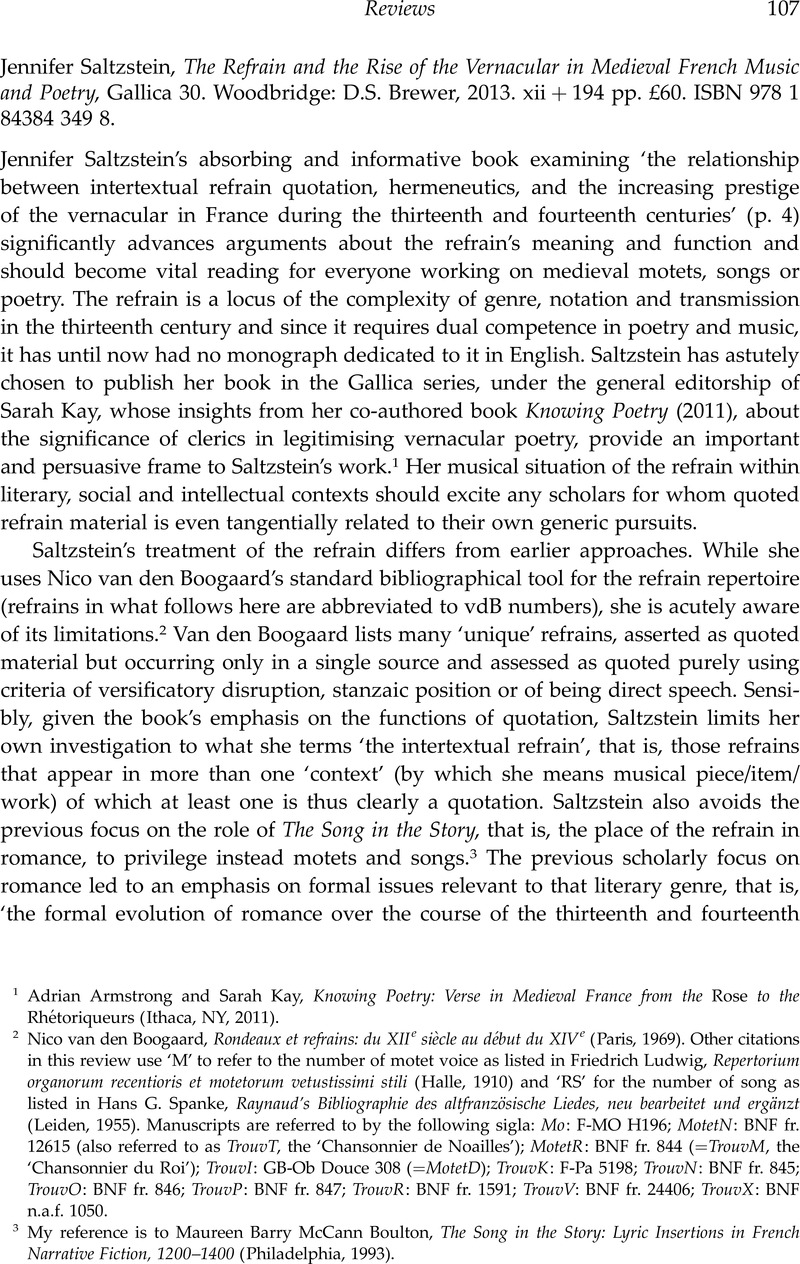No CrossRef data available.
Article contents
Jennifer Saltzstein, The Refrain and the Rise of the Vernacular in Medieval French Music and Poetry, Gallica 30. Woodbridge: D.S. Brewer, 2013. xii+194 pp. £60. ISBN 978 1 84384 349 8.
Published online by Cambridge University Press: 26 February 2014
Abstract

- Type
- Reviews
- Information
- Copyright
- Copyright © Cambridge University Press 2014
References
1 Armstrong, Adrian and Kay, Sarah, Knowing Poetry: Verse in Medieval France from the Rose to the Rhétoriqueurs (Ithaca, NY, 2011)CrossRefGoogle Scholar.
2 van den Boogaard, Nico, Rondeaux et refrains: du XIIe siècle au début du XIVe (Paris, 1969)Google Scholar. Other citations in this review use ‘M’ to refer to the number of motet voice as listed in Ludwig, Friedrich, Repertorium organorum recentioris et motetorum vetustissimi stili (Halle, 1910)Google Scholar and ‘RS’ for the number of song as listed in Spanke, Hans G., Raynaud's Bibliographie des altfranzösische Liedes, neu bearbeitet und ergänzt (Leiden, 1955)Google Scholar. Manuscripts are referred to by the following sigla: Mo: F-MO H196; MotetN: BNF fr. 12615 (also referred to as TrouvT, the ‘Chansonnier de Noailles’); MotetR: BNF fr. 844 (=TrouvM, the ‘Chansonnier du Roi’); TrouvI: GB-Ob Douce 308 (=MotetD); TrouvK: F-Pa 5198; TrouvN: BNF fr. 845; TrouvO: BNF fr. 846; TrouvP: BNF fr. 847; TrouvR: BNF fr. 1591; TrouvV: BNF fr. 24406; TrouvX: BNF n.a.f. 1050.
3 My reference is to Boulton, Maureen Barry McCann, The Song in the Story: Lyric Insertions in French Narrative Fiction, 1200–1400 (Philadelphia, 1993)CrossRefGoogle Scholar.
4 See, for example, Bradley, Catherine A., ‘New Texts for Old Music: Three Early Thirteenth-Century Latin Motets’, Music & Letters 93 (2012), 149–69CrossRefGoogle Scholar; eadem, ‘Contrafacta and Transcribed Motets: Vernacular Influences on Latin Motets and Clausulae in the Florence Manuscript’, Early Music History 32 (2013), 1–70.
5 See Rokseth, Yvonne, ed., Polyphonies du treizième siècle, 4 vols. (Paris, 1935–39)Google Scholar; Waite, William G., The Rhythm of Twelfth-Century Polyphony: Its Theory and Practice (New Haven, 1954)Google Scholar; Frobenius, Wolf, ‘Zum genetischen Verhältnis zwischen Notre-Dame-Klauseln und ihren Motetten’, Archiv für Musikwissenschaft 44 (1987), 1–39CrossRefGoogle Scholar; and Büttner, Fred, Das Klauselrepertoire der Handschrift Saint-Victor (Paris, BN, lat. 15139): eine Studie zur mehrstimmigen Komposition im 13. Jahrhundert (Lecce, 2011)Google Scholar.
6 My interpretation along these lines in Sung Birds: Music, Nature, and Poetry in the Later Middle Ages (Ithaca, NY, 2007), 97–100 is based on Stone, Gregory B., The Death of the Troubadour: The Late Medieval Resistance to the Renaissance (Philadelphia, 1994), chapter 4CrossRefGoogle Scholar; see also Simpson, James, ‘“For al my body … weieth nat an unce”: Empty Poets and Rhetorical Weight in Lydgate's Churl and the Bird’, in John Lydgate: Poetry, Culture, and Lancastrian England, ed. Scanlon, Larry and Simpson, James (Notre Dame, IN, 2005), 129–46Google Scholar.
7 See, for example, Cerquiglini, Jacqueline, “Un engin si soutil”: Guillaume de Machaut et l'écriture au XIVe siècle (Geneva, 1985)Google Scholar.
8 She finds it elsewhere only in Moniot de Paris and Perrin d'Angicourt; see p. 126.
9 The attempt at a table (p. 155) typically fails to make proper use of tabulation and is, in effect, merely a list.
10 M508 in MotetR and TrouvT; M492 in Mo.
11 RS 1596 is in TrouvK, TrouvN, TrouvX; TrouvV, TrouvR, TrouvO; and TrouvM.
12 Tischler, Hans, Trouvère Lyrics with Melodies: Complete Comparative Edition (Neuhausen, 1997)Google Scholar.
13 In TrouvP, fol. 146.




